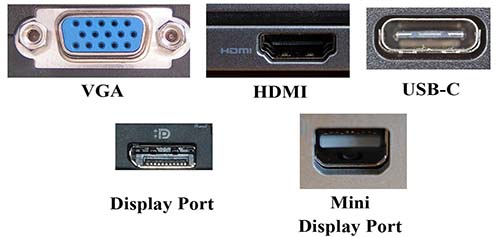There are a lot of times you might want to see your laptop on your living room TV, a Vimeo video, a Zoom meeting, a game, an unusual video file or website. You may have everything you need to connect laptop to TV.
Wireless Options
A Chromecast device (Mac and PC about $30) is an easy way to cast a laptop to a TV. Some TVs have Chromecast built-in. A second wireless casting device is Apple TV which requires a Mac computer. Just click the AirPlay icon in your Mac menu bar. Your laptop screen is cast on the TV. When you cast wirelessly with either device you may find the stream to be a bit choppy which is a problem for video or games. I have not seen this issue so much on Chromecast.
Wired Options
There are quite a few wired connection options so finding the right cable may be the biggest challenge.
VGA is an older connection so it is rare in modern computers and TVs. You will typically need a device to convert the VGA to HDMI like this one.
HDMI is a standard port on modern TVs for transmitting video and audio over a cable. If your computer has an HDMI port, this will be the easiest way to get the job done. You probably already have an HDMI cable for your streaming box, game console, or other device for your laptop. If so, borrow it for this purpose. There are also Mini and Micro HDMI ports, but these are less common.
DisplayPort is another port that you may find on your laptop, but probably not on your TV so again you need an adapter.
Mini DisplayPort is a smaller version intended for thinner laptops.
USB-C port is more common on laptops and many TVs have it as well. You can insert cables either way up so there’s no messing with the proper orientation.
And of course, there are more. DVI is another old one that is no longer seen very often. And we can’t forget Mini DVI.
This chart will show some of the more common ports, but they are not to scale.

Cable to connect laptop to TV
Now that you’ve determined which port your laptop has, you’ll want to jump over to Amazon to find the exact adapter you need to hook your laptop to the HMDI port on your TV. If you have an older machine that cannot carry audio through its display port, you may need a separate cable for audio.
This was the hard part. The easy part is tweaking the image for viewing on the TV. First switch your TV input to the input you have plugged the cable into. For instance HDMI 3. Your laptop screen appears on TV although the image quality may not be right. This could happen when the TV mirrors the laptop and scales it to fit. Or it could be extending your laptop to the TV as a second monitor.
Here’s How To Fix the Image
On a PC just right click an empty part of the desktop. Choose Display Settings. Scroll down to the Multiple Displays dropdown and choose the setting to show your desktop only on one of the two screens. This will look better than showing the same image on both screens. Now scroll down to Display Resolution. If your TV is 1080p, choose 1920x 1080. If it is 4K, choose 3840 x 2160. Older computers may not be able to handle 4K so choose 1080p.
On a Mac, go to System Preferences/ Displays. Click on Arrangement. Now you will see the Mirror Displays box. Checked it will show both screens the same. If you show the same image on both screens, go to the Display tab, open the Optimize For dropdown. You can now choose your TV from the list.
If your TV still does not look right, you can adjust it by going to the TV’s Settings and look for Overscan, Screen Fit or Aspect Ratio and experiment with the settings. Some TVs have an option for connecting a PC. IN some cases this setting will make text appear sharper on the TV. There are other settings like Full RGB or Limited RGB which can match the color space in both the laptop and the TV. But this may not be worth your time unless you plan to cast your laptop to the TV most of the time or for very important events.
Unfortunately TVs do not use standard terminology, but Google is your friend in learning to tweak a specific TV model. I hope this has helped you connect laptop to TV.






I have a Laptop, an Amazon Firestick and an Android TV box all hooked to our HD TV. I can get any Channel in the world, any movie a ever made. I was until this year a NASCAR fan, and I refuse to watch it on TSN, they add all kinds of stuff and we miss laps and accidents while they are airing that stuff, so I watch NASCAR on USA channels. Screw the CRTC, it is 2020 and I will watch the channels I want to watch